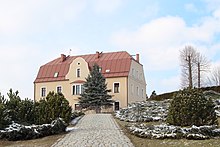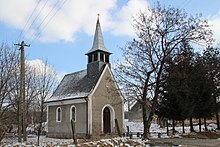Biskupów
| Biskupów Bischofswalde |
||
|---|---|---|

|
|
|
| Basic data | ||
| State : | Poland | |
| Voivodeship : | Opole | |
| Powiat : | Nysa | |
| Gmina : | Głuchołazy | |
| Geographic location : | 50 ° 31 ' N , 17 ° 22' E | |
| Residents : | 844 (March 31, 2011) | |
| Postal code : | 48-340 | |
| Telephone code : | (+48) 77 | |
| License plate : | ONY | |
| Economy and Transport | ||
| Next international airport : | Wroclaw | |
Biskupów (German Bischofswalde ) is a village in the rural community Głuchołazy (goat neck ) in Poland . It is located in the powiat Nyski (Neisse district) in the Opole Voivodeship .
geography
Geographical location
The street village of Biskupów is located in the southwest of the historical region of Upper Silesia . The place is about ten kilometers northwest of the municipal seat Głuchołazy ( goat neck ), about 16 kilometers southwest of the district town of Nysa and about 70 kilometers southwest of the voivodeship capital Opole . Approx. The border with the Czech Republic runs six kilometers southwest of the village .
The place lies in the Przedgórze Sudeckie (Sudeten foothills) within the Przedgórze Paczkowskie (Patschkauer foothills) . Biskupów is located on the moor water (Polish Mora ). The place was until the closure on the Nowy Świetów – Sławniowice Nyskie railway , a branch line of the Katowice – Legnica railway .
District
The district of Biskupów is Łączki ( Lentsch ).
Neighboring places
Neighboring towns of Biskupów are in the northeast Markowice ( Markersdorf ), in the east Wilamowice Nyskie ( Winsdorf ), in the southeast Gierałcice ( Giersdorf ), in the southwest Burgrabice ( Borkendorf ), in the west Kijów ( Kaindorf ) and in the northwest Nadziejów ( Naasdorf ).
history
"Biscopeswalde" was first mentioned in 1231. The spelling “Byssephswalde” is documented for 1284, “Bissofwalde” for 1285, “Byssophswalde” for 1289 and “Byssowswalde” in the Liber fundationis episcopatus Vratislaviensis from the years 1295–1305. It belonged to the principality of Neisse , with which it fell to Prussia after the First Silesian War with most of Silesia .
After the reorganization of the province of Silesia which belonged rural community Bischofswalde from 1816 to district Neisse in the administrative district of Opole . In 1829 a new school house was built in the village. In 1845 there was a castle, a Catholic church, a Catholic school and 184 other houses in the village. In the same year, 1152 people lived in Bischofswalde, one of them Protestant. In 1855 965 people lived in the village. In 1865 there were 34 farmers, 26 gardeners and 38 cottagers as well as a water mill and several quarries in the village . In 1874 the district of Bischofswalde was founded, which consisted of the rural communities of Bischofswalde and Lentsch and the manor districts of Großhof, Kleinhof, Kleinwalde and Lentsch. The first head of office was the landowner Lorenz in Bischofswalde. In 1885 Bischofswalde had 884 inhabitants. In 1894 the village received a connection to the Upper Silesian Railway on the Nowy Świetów – Sławniowice Nyskie line .
In 1933 there were 1026 people in Bischofswalde and 1018 in 1939. Until 1945 the place was in the district of Neisse .
In 1945 Bischofswalde came under Polish administration and was renamed Biskupów . From 1950 it belonged to the Opole Voivodeship and from 1999 to the re-established Powiat Nyski .
Attractions
- The Roman Catholic parish church of the Annunciation ( Kościół Zwiastowania NMP ) is located on a hill north of the village center. There was a church here as early as the first half of the 14th century. This building was rebuilt in the baroque style in 1770. The nave has a needle cap barrel, the choir a ribbed vault. The bell tower was built in 1750 and provided with an onion dome. On the south side of the church there is a gable in the Renaissance style . The interior furnishings come mainly from the renovation period of 1770. The main altar was made in 1787. The church is surrounded by a stone wall from the 18th century. The church building has been a listed building since 1950.
- The Castle Bischofswalde was built in 1907 and now serves as a residence.
- The old Bischofswalde manor was built in the 18th century. Remnants of the former estate park have been preserved to this day.
- The former station building of the Bischofswalde train station was erected in 1894 as a brick building. Today it serves as a residential building.
- Building of the former Benedictine monastery - built in 1911
- The Assumption Chapel in Lentsch was built in 1932
- Stone path chapel from the second half of the 19th century
- Brick path chapel with statue of the Virgin Mary
- Path chapel with crucifixion group
- Monument to Pope John Paul II
societies
- LZS Błękitni Biskupów football club
Personalities
- Johannes Ronge (1813–1887), Catholic priest
- Joseph Jahnel (1834–1897), prince-bishop delegate
Web links
Individual evidence
- ^ CIS 2011: Ludność w miejscowościach statystycznych według ekonomicznych grup wieku (Polish), March 31, 2011, accessed on December 1, 2018
- ↑ Liber fundationis episcopatus Vratislaviensis
- ↑ Bernhard W. Scholz: The spiritual principality of Neisse . 2011 Böhlau Verlag Cologne Weimar Vienna, ISBN 978-3-412-20628-4 [With a map of the villages and towns of the Principality of Neisse 1650 on the trailer]
- ^ Johann Georg Knie : Alphabetical-statistical-topographical overview of the villages, spots, cities and other places of the royal family. Preuss. Province of Silesia. Breslau 1845, p. 39.
- ↑ Cf. Felix Triest: Topographisches Handbuch von Oberschlesien. Breslau 1865, p. 1027.
- ^ Territorial district of Bischofswalde
- ↑ AGoFF circle Neisse
- ^ Michael Rademacher: German administrative history from the unification of the empire in 1871 to the reunification in 1990. Neisse district (Polish Nysa). (Online material for the dissertation, Osnabrück 2006).
- ^ Dehio Handbook of Art Monuments in Poland. Silesia. Deutscher Kunstverlag, Munich et al. 2005, ISBN 3-422-03109-X , p. 145.
- ↑ Monument register of the Opole Voivodeship (Polish; PDF; 913 kB)
- ↑ a b c d e f Gmina Głuchołazy Monument Register (Polish)




